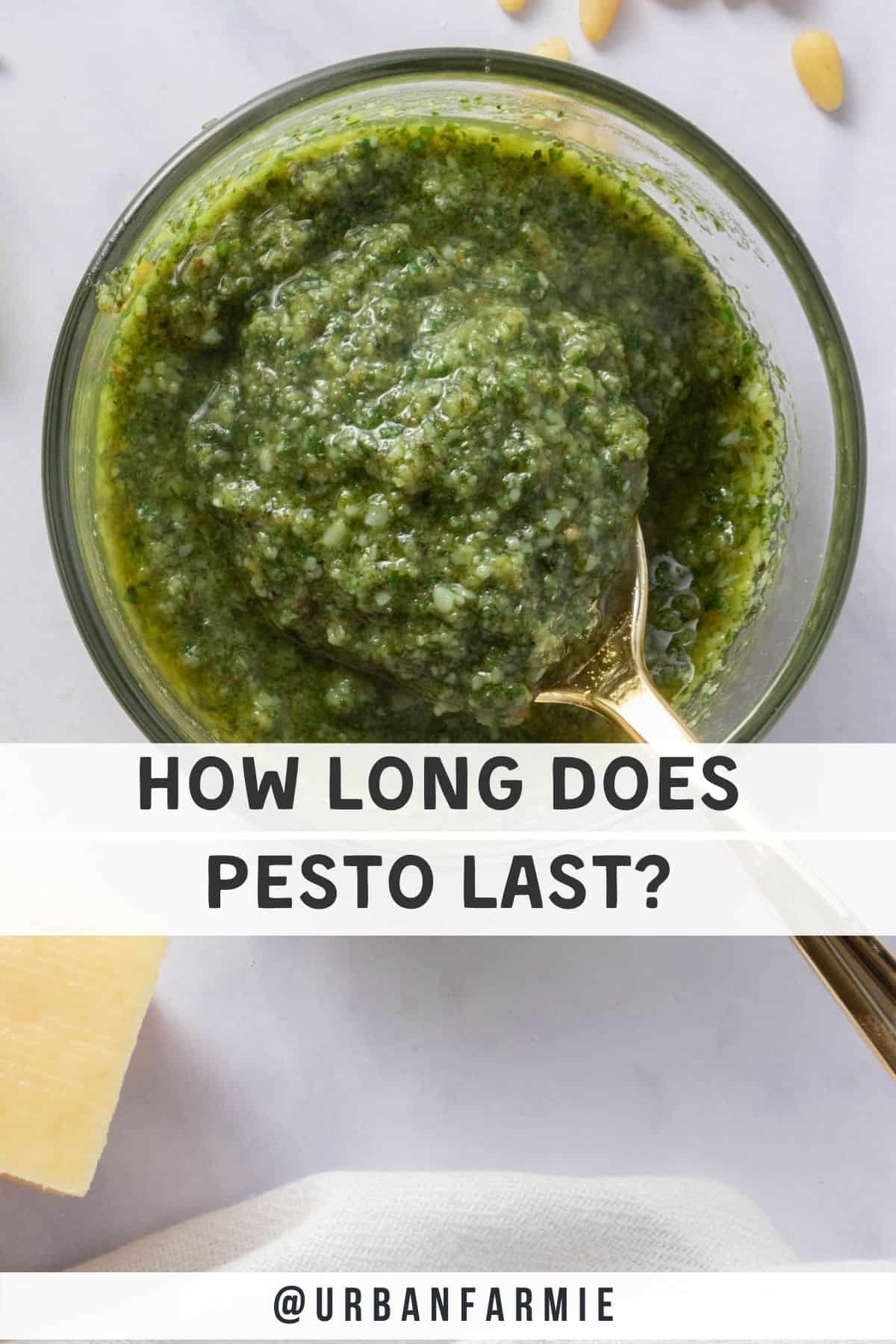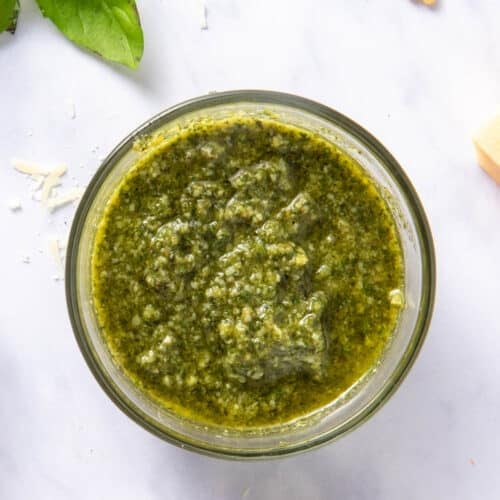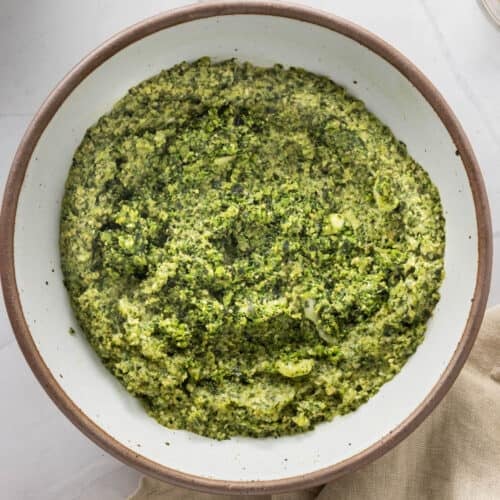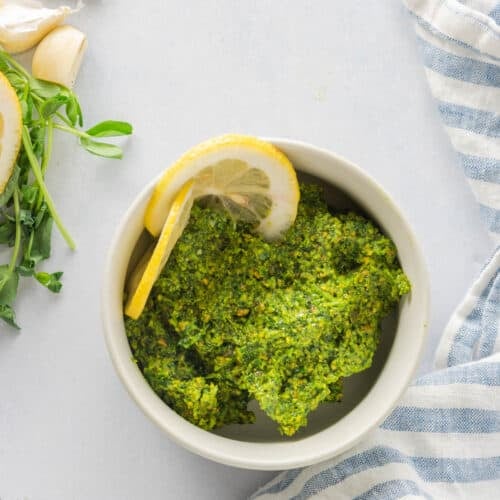This post contains helpful tips and tricks! If you’re in a rush, please use the “Jump to Recipe” above!
How long does pesto last?
Pesto (especially homemade basil pesto) is one of those magical ingredients that can make just about anything taste delicious. But, like all other sauces and dips, has a short shelf life. It typically comes in four forms:
Store bought, refrigerated: this is typically sold in the refrigerated section of your grocery store. Store bought, canned: this is unrefrigerated and typically found in the pasta and sauces section of the grocery store. Store bought, powdered: this is a powder packet that is also unrefrigerated and found in the pasta and sauces section of the grocery store. Homemade pesto that you can make at home (e.g., like my traditional basil pesto, nut-free, vegan kale pesto, pea shoot pesto or even broccoli pesto)
After that, the flavors will start to deteriorate and it will lose its bright green color. To understand more about the nuances of how long pesto lasts, and learn how to make it last even longer, read the rest of the post! Feel free to use the table of contents above to skip to the section you want.
How long does pesto last in the fridge?
Pesto will typically last longer in the fridge, regardless of the type. The National Center for Home Food Preservation suggests it should be made fresh and stored in the fridge for no more than 3 days. However, it may be frozen for longer term storage. However, the actual shelf life in the fridge will depend on its form.
How long does pesto last in the freezer?
To maximize shelf life of pesto, it’s best to freeze it. This can prolong the shelf life to a couple of months versus a couple of weeks for most forms.
Things that affect the shelf life of pesto
There are just two main things you need to be aware of:
The ingredients used The container it’s stored in
Ingredients
There are three ingredients that might affect the shelf life of pesto:
Nuts: All nuts contain oils, which can go rancid. The higher the percentage of oil, the faster it will go rancid. When you use nuts, you are combining two ingredients that have a shorter shelf life.Basil (or other herbs): Like nuts, herbs easily decay, because they are mostly made up of water. Since it’s mostly made of herbs, depending on the freshness and quality of herbs, the pesto can be more likely to spoil.Oil: Oil is the other key ingredient with high potential to go rancid.
As a result, choosing the freshest ingredients is the best way to prolong the life of the pesto.
Container
The container used to store pesto really does affect it’s shelf life. If you’re looking to store it in your fridge, be sure to use an airtight container or plastic freezer bags. A container that is not airtight will cause it to oxidize and turn brown. If you’re looking to store your pesto in the freezer, be sure to use freezer-safe containers. A container that is not freezer-safe will cause the pesto to lose its flavor.
How can you tell if pesto has gone bad?
As much as we might try, occasionally, I’ve made pesto, only to have it spoil a few days later. It’s such a shame when that happens! However, it’s easy to tell if it’s gone bad based on four indicators: mold growth, color, smell, and taste.
Mold growth
Mold growth is the most obvious sign that your pesto has gone bad. If you see mold growing on the surface, it’s best to discard the container right away.
Color
You can tell that pesto has gone bad if it changes color from green to brown or black. Once you notice it’s changed its color from green to brown then it’s time to say goodbye to your condiment.
Smell
Another thing that’s a surefire way to tell it’s has gone bad is the smell. If it’s gone bad, then it will have a sour, almost chemical smell. This is because the olive oil and nuts have gone rancid. So, give it a good sniff, before you decide to use it to avoid any problems. If it doesn’t smell good, then don’t use it.
Taste
If pesto tastes sour and a bit harsh (or watery and bland), then it’s time to throw it away. If you’re not sure whether it’s still good, taste a small amount first and then decide. When in doubt, always better to be safe!
Tips to extend shelf life of pesto
Pesto is versatile, but it can be expensive to buy in the store. And even more painful if it goes bad after you’ve made lots of delicious plans with it. By learning a few tricks, you can extend the shelf life, making it last for weeks instead of days.
Unrefrigerated pesto
If you have unrefrigerated pesto (i.e., if you bought it in a can at a store) at home, it will last longest if kept in a cool, room temperature, dry area. Once opened, seal the container tightly to keep out high moisture content and oxygen. You can also always throw it in the fridge to be sure. Because it’s an oil-based sauce, it will spoil and go rancid after a while if exposed to air. So if you see it start get exposed to air, you can top the jar with some high quality olive oil to cut off contact with air. Good news is that store-bought pesto will come with instructions on the label. Be sure to follow these instructions for optimal freshness!
Refrigerated or homemade pesto
Pesto will last the longest in the fridge, but it needs to be stored properly to prevent spoilage. Always store it in the fridge, even if it hasn’t been opened yet. Once you have opened the jar, be sure to seal the container tightly and top it off with oil to prevent exposure to air and spoilage.
How to freeze pesto?
Freezing homemade or commercial pesto helps extend its shelf life even further. To do this:
Pack it into small freezer-safe plastic containers or heavy-duty freezer bags, leaving some headspace for expansion (approximately ½-inch headspace).You can also freeze it in ice cube trays and then transfer the cubes to a freezer-safe bag or sealed container once they’re frozen.You should put a label on the freezer-safe bag with the name and use date so you can keep track of how long it’s been in the freezer.
When frozen, pesto lasts somewhere between six months (homemade) to eight months (store-bought).
Botulism
Pesto is a low acid food (because both fresh basil and oil are low acid foods), which means there is a risk of botulism if it’s not stored properly. Botulism is a serious foodborne illness that can cause paralysis and even death. Botulism causing bacteria typically grow in low-acid foods that are stored improperly.
Causes
Botulism is a serious and potentially fatal form of food poisoning. It is caused by the c. botulinum carrier, which is found in soil and contaminated food. The bacteria produce a toxin that can cause paralysis of the muscles, including the respiratory muscles. Botulism can occur in two forms: food-borne and wound. Food-borne botulism is the more common form and occurs when contaminated food is eaten. Wound botulism occurs when the bacteria enter an open wound and produce the toxin.
Symptoms
Symptoms can take up to 18-36 hours to appear, and they include:
NauseaStomach painDiarrheaWeakening of the musclesDry mouthBlurred VisionDouble VisionDrooping eyelidsSlurred speechDifficulty in swallowing, moving eyes, and breathing
If you have the symptoms of botulism, seek medical attention immediately.
My favorite pesto recipes
To start with, you might want to check out a few types I have on the blog: Then, use it up in some delicious and versatile recipes:









